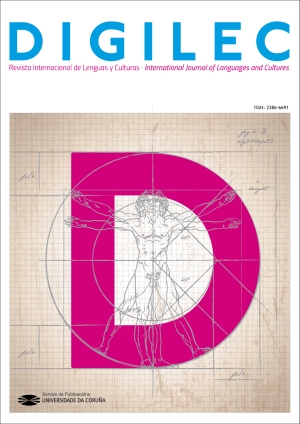Análisis de la propuesta matrimonial del señor Collins: el realismo de Jane Austen como estrategia para la crítica social
Contenido principal del artículo
Resumen
Las novelas de Jane Austen son un fiel retrato de muchas de las costumbres y reglas de la sociedad de su tiempo. Al reflejar el entorno sociocultural de su época, la autora confiere un mayor realismo a sus obras y aporta coherencia a la actitud de sus personajes. Austen se sirve también del realismo para realizar una sutil crítica social, poniendo de manifiesto las consecuencias negativas de algunas de las disposiciones de su época.
En el presente artículo, se ofrece un análisis del capítulo 19 de Pride and Prejudice, en el que se relata la propuesta de matrimonio de Mr. Collins a Elizabeth Bennet. Por medio de este análisis, precedido de un contexto sociocultural sobre los clérigos, el cortejo, las propuestas matrimoniales y el entailment, un instrumento legal, se explicará el modo en el que Austen critica la situación de precariedad de las mujeres de su época y las consecuencias de esta situación en los compromisos matrimoniales.
Palabras clave:
Descargas
Detalles del artículo
Citas
Al-Haj, A. A. M. (2014). The Portrayal of Male Fools in Jane Austen Pride and Prejudice. English language and Literature Studies, 4 (2), 44-50.
Ailwood, S. (2021). Jane Austen, Feminist Legal Philosopher. In M. Kramp (Ed.), Jane Austen and Critical Theory, 232-247. London: Routledge.
Appel, P. A. (2012). A Funhouse Mirror of Law: The Entailment in Jane Austen’s Pride and Prejudice. Georgia Journal of International and Comparative Law, 41 (3), 609-636.
Austen, J. (2011). Jane Austen’s Letters. D. Le Faye (Ed.), Oxford: Oxford University Press.
Austen, J. (1853). Pride and Prejudice. London: Richard Bentley.
Austen, J. (1833). Sense and Sensibility. London: Richard Bentley.
Austen, J. (1988). Mansfield Park. R. W. Chapman (Ed.), Oxford: Oxford University Press.
Austen, J. (2011). Persuasion: An Annotated Edition. R. Morrison (Ed.), Cambridge MA: Harvard University Press.
Barrie-Curien, V. (1992). Clergé et pastorale en Angleterre au XVIIIè siècle: le diocèse de Londres. [Clergy and pastoral in England during the eighteenth century: the diocese of London]. Paris: Editions du Centre national de la recherche scientifique.
Brownstein, R. M. (1988). Jane Austen: irony and authority. Women’s Studies: An Interdisciplinary Journal, 15 (1-3), 57-70.
Cecil, E. (1895). Primogeniture: A Short History of Its Development in Various Countries and Its Practical Effects. London: J. Murray.
Clark, G. K. (2018). Churchmen and the Condition of England 1832-1885: A Study in the Development of Social Ideas and Practice from the Old Regime to the Modern State. London: Taylor & Francis Limited.
Eustace, N. (2001) “The cornerstone of a copious work”: love and power in eighteenth-century courtship. Journal of Social History, 34 (3), 517-546.
Hempton, D. (1996). Religion and Political Culture in Britain and Ireland: From the Glorious Revolution to the Decline of Empire. Cambridge: Cambridge University Press.
Jacob, W. M. (2007). The Clerical Profession in the Long Eighteenth Century, 1680-1840. Oxford: Oxford University Press.
Jordán, M. A. (2017). Análisis del estilo literario de Jane Austen [Analysis of the literary style of Jane Austen].
Valencia: Universitat de València, http://roderic.uv.es/handle/10550/59048.
Kloester, J. (2010). Georgette Heyer’s Regency World. Chicago: Sourcebooks, Inc.
Laumber, S. (1998). Jane Austen: Pride and Prejudice. London: Macmillan.
Macpherson, S. (2003). Rent to Own; or, What's Entailed in Pride and Prejudice. Representations, 82 (1), 1-23.
Mudrick, M. (2018). Jane Austen: Irony as defense and discovery. Great Barrington MA: Berkshire Publishing Group.
Nash, G. (1999). Jane Austen and Pride & Prejudice. London: Longman.
Partanen, H. K. (2019). “There is something very pompous in his style”: An analysis of Mr Collins’ social missteps in Pride and Prejudice. Bachelor Thesis. University of Jyväskylä
Smith, D. S. (1973). Parental power and marriage patterns: An analysis of historical trends in Hingham, Massachusetts. Journal of Marriage and the Family, 35 (3), 419-428.
Stout, J. P. (1982). Jane Austen’s proposal scenes and the limitations of language. Studies in the Novel, 14 (4), 316-326.
Puspita, M. & Pratama, P. (2019). The value of feminism in Pride and Prejudice by Jane Austen and the implications for language teaching. English Empower: Journal of Linguistics and Literature, 4 (2), 65-74.


